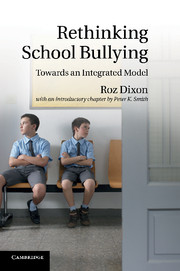Book contents
- Frontmatter
- Contents
- Acknowledgements
- Introduction
- 1 Bullying in schools: the research background
- 2 Understanding schools as systems
- 3 Bullying in groups: ostracism and scapegoating
- 4 Developing an integrated, systemic model of school bullying
- 5 Building personal bodies of knowledge to support research and practice
- 6 Building a public body of knowledge to support research and practice
- 7 Conclusion
- References
- Index
4 - Developing an integrated, systemic model of school bullying
Published online by Cambridge University Press: 28 April 2011
- Frontmatter
- Contents
- Acknowledgements
- Introduction
- 1 Bullying in schools: the research background
- 2 Understanding schools as systems
- 3 Bullying in groups: ostracism and scapegoating
- 4 Developing an integrated, systemic model of school bullying
- 5 Building personal bodies of knowledge to support research and practice
- 6 Building a public body of knowledge to support research and practice
- 7 Conclusion
- References
- Index
Summary
The initial impetus for the programme of research discussed in Chapters 2 and 3 came from clinical work with families of children who are deaf. The central question was, ‘Why are some deaf children bullied and what are the implications for intervention?’ In deciding what research to undertake, an important factor was the contention by the specialist psychotherapist Harvey (1989) that the behaviour and experience of children who are deaf is highly influenced by the powerful systems that encapsulate them (family, professionals, peers and so forth). However, whilst this is particularly true of children who are deaf, it is a principle that applies to all children. One aim of the research was to identify which parts of the deaf child's system are relevant in the development and management of bullying. Another was to map how these parts might interact with one another to exacerbate or reduce bullying. To this end, two studies were undertaken: a case study of a secondary, mainstream school (Chapter 2) and a retrospective study with adults who were deaf or hearing impaired (Chapter 3). The case study identified the ways in which bullying and the management of bullying are embedded within the overall network of relationships that is a school. The retrospective study sampled the breadth of experiences and range of influences on deaf children's peer relationships, identifying some common patterns across the range of school settings.
- Type
- Chapter
- Information
- Rethinking School BullyingTowards an Integrated Model, pp. 118 - 140Publisher: Cambridge University PressPrint publication year: 2011



